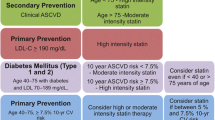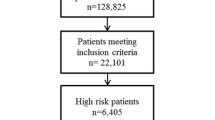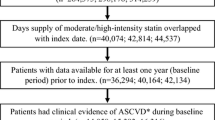Abstract
OBJECTIVE: To determine whether outpatient cholesterol management varies by gender or race among patients with atherosclerosis, and assess factors related to subsequent cholesterol control.
DESIGN: Retrospective cohort study.
SETTING: Primary care clinics affiliated with an academic medical center.
PARTICIPANTS: Two hundred forty-three patients with coronary heart disease, cerebrovascular disease, or peripheral vascular disease and low-density lipoprotein cholesterol (LDL-C)> 130 mg/dl.
MEASUREMENTS AND MAIN RESULTS: The primary process of care assessed for 1,082 office visits was cholesterol management (medication intensification or LDL-C monitoring). Cholesterol management occurred at 31.2% of women’s and 38.5% of men’s visits (P=.01), and 37.3% of black and 31.7% of white patients’ visits (P=.09). Independent predictors of cholesterol management included female gender (adjusted risk ratio [ARR], 0.77; 95% confidence interval [CI], 0.60 to 0.97), seeing a primary care clinician other than the patient’s primary care physician (ARR, 0.23; 95% CI, 0.11 to 0.45), and having a new clinical problem addressed (ARR, 0.60; 95% CI, 0.48 to 0.74). After 1 year, LDLC <130 mg/dl occurred less often for women than men (41% vs 61%; P=.003), black than white patients (39% vs 58%; P=.01), and patients with only Medicare insurance than with commercial insurance (37% vs 58%; P=.008). Adjustment for clinical characteristics and management attenuated the relationship between achieving an LDL-C <130 mg/dl and gender.
CONCLUSIONS: In this high-risk population with uncontrolled cholesterol, cholesterol management was less intensive for women than men but similar for black and white patients. Less intense cholesterol management accounted for some of the disparity in cholesterol control between women and men but not between black and white patients.
Similar content being viewed by others
References
Tobin JN, Wassertheil-Smoller S, Wexler JP, et al. Sex bias in considering coronary bypass surgery. Ann Intern Med. 1987;107:19–25.
Ayanian JZ, Epstein AM. Differences in the use of procedures between women and men hospitalized for coronary heart disease. N Engl J Med. 1991;325:221–5.
Krumholz HM, Douglas PS, Lauer MS, Pasternak RC. Selection of patients for coronary angiography and coronary revascularization early after myocardial infarction: is there evidence for a gender bias? Ann Intern Med. 1992;116:785–90.
Udvarhelyi IS, Gatsonis C, Epstein AM, Pashos CL, Newhouse JP, McNeil BJ. Acute myocardial infarction in the Medicare population: process of care and clinical outcomes. JAMA. 1992;268:2530–6.
Sheifer SE, Escarce JJ, Schulman KA. Race and sex differences in the management of coronary artery disease. Am Heart J. 2000;139:848–57.
Oberman A, Cutter G. Issues in the natural history and treatment of coronary heart disease in black populations: surgical treatment. Am Heart J. 1984;108:688–94.
Maynard C, Fisher LD, Passamani ER, Pullum T. Blacks in the coronary artery surgery study (CASS): race and clinical decision making. Am J Public Health. 1986;76:1446–8.
Wenneker MB, Epstein AM. Racial inequalities in the use of procedures for patients with ischemic heart disease in Massachusetts. JAMA. 1989;261:253–7.
Ayanian JZ, Udvarhelyi IS, Gatsonis CA, Pashos CL, Epstein AM. Racial differences in the use of revascularization procedures after coronary angiography. JAMA. 1993;269:2642–6.
Whittle J, Conigliaro J, Good CB, Lofgren RP. Racial differences in the use of invasive cardiovascular procedures in the Department of Veterans Affairs medical system. N Engl J Med. 1993;329:621–7.
Peterson ED, Shaw LK, DeLong ER, Pryor DB, Califf RM, Mark DB. Racial variation in the use of coronary-revascularization procedures. Are the differences real? Do they matter? N Engl J Med. 1997;336:480–6.
Kostis JB, Wilson AC, O’Dowd K, et al. for the MIDAS Study Group. Sex differences in the management and long-term outcome of acute myocardial infarction: a statewide study. Circulation. 1994;90:1715–30.
Bickell NA, Pieper KS, Lee KL, et al. Referral patterns for coronary artery disease treatment: gender bias or good clinical judgment? Ann Intern Med. 1992;116:791–7.
Gornick ME, Eggers PW, Reilly TW, et al. Effects of race and income on mortality and use of services among Medicare beneficiaries. N Engl J Med. 1996;335:791–9.
Daumit GL, Hermann JA, Coresh J, Powe NR. Use of cardiovascular procedures among black persons and white persons: a 7-year nation-wide study in patients with renal disease. Ann Intern Med. 1999;130:173–82.
Gregory PM, Rhoads GG, Wilson AC, O’Dowd KJ, Kostis JB. Impact of availability of hospital-based invasive cardiac services on racial differences in the use of these services. Am Heart J. 1999;138:507–17.
Schecter AD, Goldschmidt-Clermont PJ, McKee G, et al. Influence of gender, race, and education on patient preferences and receipt of cardiac catheterizations among coronary care unit patients. Am J Cardiol. 1996;78:996–1001.
Sedlis SP, Fisher VJ, Tice D, Esposito R, Madmon L, Steinberg EH. Racial differences in performance of invasive cardiac procedures in a Department of Veterans Affairs Medical Center. J Clin Epidemiol. 1997;50:899–901.
Whittle J, Conigliaro J, Good CB, Joswiak M. Do patient preferences contribute to racial differences in cardiovascular procedure use? J Gen Intern Med. 1997;12:267–73.
Schulman KA, Berlin JA, Harless W, et al. The effect of race and sex on physicians’ recommendations for cardiac catheterization. N Engl J Med. 1999;340:618–26.
Schrott HG, Bittner V, Bittinghoff E, et al. Adherence to national cholesterol education program treatment goals in postmenopausal women with heart disease: the Heart and Estrogen/Progestin Replacement Study (HERS). JAMA. 1997;277:1281–6.
Pearson TA, Laurora I, Chu H, Kafonek S. The Lipid Treatment Assessment Project (L-TAP): a multicenter survey to evaluate the percentages of dyslipidemic patients receiving lipid-lowering therapy and achieving low-density lipoprotein cholesterol goals. Arch Intern Med. 2000;160:459–67.
Maviglia SM, Teich JM, Fiskio J, Bates DW. Using an electronic medical record to identify opportunities to improve compliance with cholesterol guidelines. J Gen Intern Med. 2001;16:531–7.
Miller M, Byington R, Hunninghake D, Pitt B, Furberg CD. Sex bias and underutilization of lipid-lowering therapy in patients with coronary artery disease at academic medical centers in the United States and Canada. Arch Intern Med. 2000;160:343–7.
Qureshi AI, Suri MF, Guterman LR, Hopkins LN. Ineffective secondary prevention in survivors of cardiovascular events in the US population: report from the Third National Health and Nutrition Examination Survey. Arch Intern Med. 2001;161:1621–8.
Nohria A, Vaccarino V, Krumholz HM. Gender differences in mortality after myocardial infarction: why women fare worse than men. Cardiol Clin. 1998;16:45–57.
Ayanian JZ, Landrum MB, McNeil BJ. Use of cholesterol-lowering therapy by elderly adults after myocardial infarction. Arch Intern Med. 2002;162:1013–9.
Majumdar SR, Gurwitz JH, Soumerai SB. Undertreatment of hyperlipidemia in the secondary prevention of coronary artery disease. J Gen Intern Med. 1999;14:711–7.
McCormick D, Gurwitz JH, Lessard D, Yarzebski J, Gore JM, Goldberg RJ. Use of aspirin, beta-blockers, and lipid-lowering medications before recurrent acute myocardial infarction: missed opportunities for prevention? Arch Intern Med. 1999;159:561–7.
Fonarow GC, French WJ, Parsons LS, Sun H, Malmgren JA. Use of lipid-lowering medications at discharge in patients with acute myocardial infarction: data from the National Registry of Myocardial Infarction 3. Circulation. 2001;103:38–44.
Naumburg EH, Franks P, Bell B, Gold M, Engerman J. Racial differentials in the identification of hypercholesterolemia. J Fam Pract. 1993;36:425–30.
Ayanian JZ, Landon BE, Landrum MB, Grana JR, McNeil BJ. Use of cholesterol-lowering therapy and related beliefs among middle-aged adults after myocardial infarction. J Gen Intern Med. 2002;17:95–102.
Nelson K, Norris K, Mangione CM. Disparities in the diagnosis and pharmacologic treatment of high serum cholesterol by race and ethnicity: data from the Third National Health and Nutrition Examination Survey. Arch Intern Med. 2002;162:929–35.
Jha AK, Varosy PD, Kanaya AM, et al. Differences in medical care and disease outcome among black and white women with heart disease. Circulation. 2003;108:1089–94.
Kerr EA, Smith DM, Hogan MM, et al. Building a better quality measure: are some patients with ‘poor quality’ actually getting good care? Med Care. 2003;41:1173–82.
Nissen D, ed. Mosby’s Drug Consult. St. Louis, MO: Mosby, Inc.; 2003.
Panel on Detection, Evaluation and Treatment of High Blood Cholesterol in Adults. Summary of the second report of the National Cholesterol Education Program (NCEP) Expert Panel on Detection, Evaluation, and Treatment of High Blood Cholesterol in Adults (Adult Treatment Panel II). JAMA. 1993;269:3015–23.
Lee TH, Cleeman JI, Grundy SM, et al. Clinical goals and performance measures for cholesterol management in secondary prevention of coronary heart disease. JAMA. 2000;283:94–8.
Zeger SL, Liang KY. Longitudinal data analysis for discrete and continuous outcomes. Biometrics. 1986;42:121–30.
Zhang J, Yu KF. What’s the relative risk? A method of correcting the odds ratio in cohort studies of common outcomes. JAMA. 1998;280:1690–1.
Pearson TA, Blair SN, Daniels SR, et al. for the American Heart Association Science Advisory and Coordinating Committee. AHA guidelines for primary prevention of cardiovascular disease and stroke: 2002 update: consensus panel guide to comprehensive risk reduction for adult patients without coronary or other atherosclerotic vascular diseases. Circulation. 2002;106:388–91.
Benner JS, Glynn RJ, Mogun H, Neumann PJ, Weinstein MC, Avorn J. Long-term persistence in use of statin therapy in elderly patients. JAMA. 2002;288:455–61.
Frolkis JP, Pearce GL, Nambi V, Minor S, Sprecher DL. Statins do not meet expectations for lowering low-density lipoprotein cholesterol levels when used in clinical practice. Am J Med. 2002;113:625–9.
Flocke SA, Stange KC, Goodwin MA. Patient and visit characteristics associated with opportunistic preventive services delivery. J Fam Pract. 1998;47:202–8.
Murray M, Bodenheimer T, Rittenhouse D, Grumbach K. Improving timely access to primary care: case studies of the advanced access model. JAMA. 2003;289:1042–6.
Federman AD, Adams AS, Ross-Degnan D, Soumerai SB, Ayanian JZ. Supplemental insurance and use of effective cardiovascular drugs among elderly Medicare beneficiaries with coronary heart disease. JAMA. 2001;286:1732–9.
Heart Protection Study Collaborative Group. MRC/BHF Heart Protection Study of cholesterol lowering with simvastatin in 20536 high-risk individuals: a randomised placebo-controlled trial. Lancet. 2002;360:7–22.
Collins R, Armitage J, Parish S, Sleight P, Peto R. Effects of cholesterol-lowering with simvastatin on stroke and other major vascular events in 20536 people with cerebrovascular disease or other high-risk conditions. Lancet. 2004;363:757–67.
Cannon CP, Braunwald E, McCabe CH, et al. Intensive versus moderate lipid lowering with statins after acute coronary syndromes. N Engl J Med. 2004;350:1495–504.
Author information
Authors and Affiliations
Corresponding author
Additional information
Dr. Bates is a consultant and serves on the advisory board for McKesson MedManagement, a company that assists hospitals in preventing adverse drug events. He is on the clinical advisory board for Voltage Inc., which compiles information on compliance for drug companies.
This work was supported in part by institutional National Research Service Award 5T32HS00020-16 (Dr. Persell) and grant RO1 #1 U18 HS11046 from the Agency for Healthcare Research and Quality, Rockville, MD.
Rights and permissions
About this article
Cite this article
Persell, S.D., Maviglia, S.M., Bates, D.W. et al. Ambulatory hypercholesterolemia management in patients with atherosclerosis. J GEN INTERN MED 20, 123–130 (2005). https://doi.org/10.1111/j.1525-1497.2005.40155.x
Accepted:
Issue Date:
DOI: https://doi.org/10.1111/j.1525-1497.2005.40155.x




